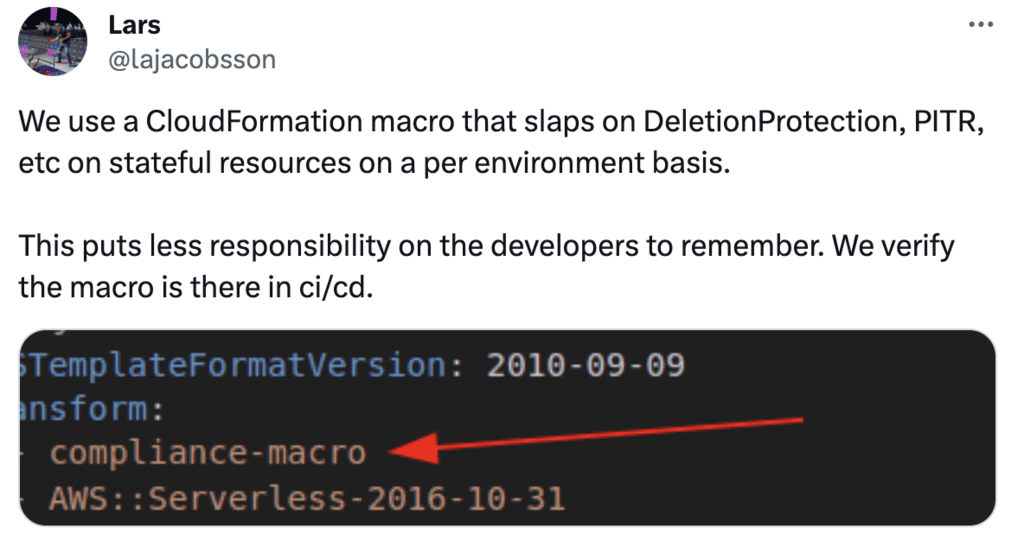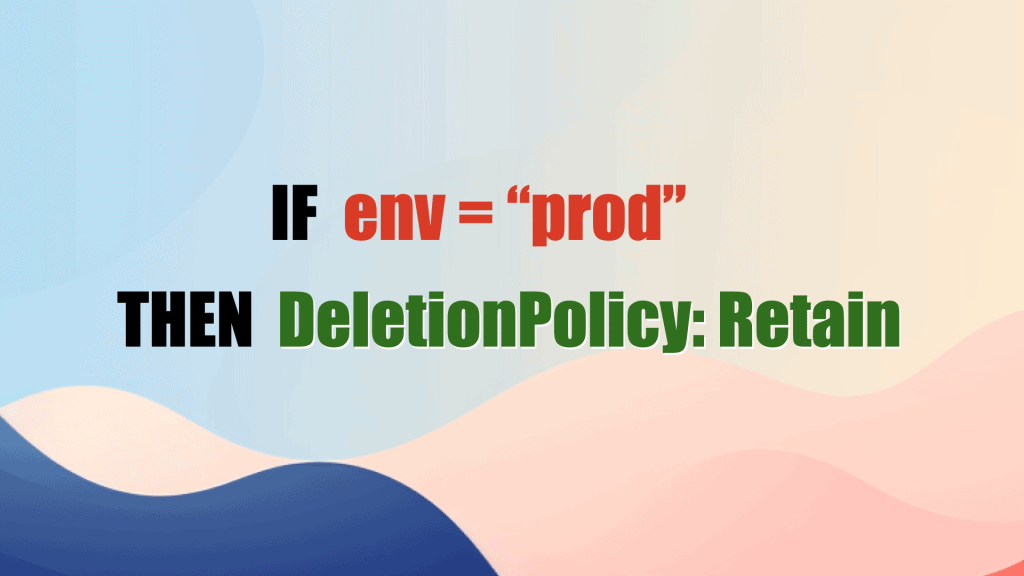
Yan Cui
I help clients go faster for less using serverless technologies.
This article is brought to you by

The real-time data platform that empowers developers to build innovative products faster and more reliably than ever before.
It’s a good practice to use CloudFormation’s deletion policy to protect stateful resources such as DynamoDB tables or RDS databases from accidental deletions. Such as when someone accidentally deletes a CloudFormation stack!
As I discussed previously [1], this is a much better way to guard against these accidental data losses than separating stateful and stateless resources into different stacks. After all, how we think about infrastructure vs. code needs to evolve in the serverless era [2]. That separation is no longer so clear-cut.
The problem with CloudFormation deletion policies
But using DeletionPolicy on stateful resources causes friction with another common practice in serverless development – using ephemeral (or temporary) environments [3].
If you set DeletionPolicy to Retain, these resources will linger when you delete the temporary environment.
In practice, you only need to use CloudFormation deletion policies in production. That’s the only environment where it’s necessary.
So, how do we do that?
The CDK solution
CDK gives you the full power of a general-purpose programming language (even though it’s often overkill [4]). So it’s trivial to do this in a CDK application:
- Pass the environment name as either a CloudFormation parameter or context variable.
- Set the
removalPolicyinside anifblock like this:
if (environment === 'prod') {
myTable.removalPolicy = cdk.RemovalPolicy.RETAIN
}
When you have branch logic like this in your CDK code, you should add unit tests for them.
And instead of using magic strings like “prod”, you should also capture constants as enums.
Additionally, you can use CDK Aspects to select multiple resources and update their policy in one go. Check out this article [5] by Wojciech Matuszewski for more details.
Serverless / SAM / CloudFormation solution
For the Serverless Framework, SAM or CloudFormation, you can do this:
- Add an
EnvironmentCloudFormation parameter. (not needed for the Serverless Framework because it has a built-instageparameter) - Add an
IsProdcondition. - Use the
!Ifintrinsic function, soDeletionPolicyis set toRetainwhen theEnvironmentis “prod”, else set it toDelete.
Like this:
Parameters:
Environment:
Type: String
Default: dev
Description: Environment name, e.g. dev, test, prod
Conditions:
IsProd: !Equals [ !Ref Environment, "prod" ]
Resources:
MyTable:
Type: AWS::DynamoDB::Table
DeletionPolicy: !If [ "IsProd", "Retain", "Delete" ]
Properties:
...
For the Serverless Framework, you can skip step 1 because it has a built-in sls:stage parameter. So the IsProd condition becomes:
Conditions:
IsProd: !Equals [ "${sls:stage}", "prod" ]
DynamoDB DeletionProtectionEnabled attribute
I have used DynamoDB in the examples above. But it’s worth pointing out that DeletionPolicy is actually not the most effective protection against data loss for DynamoDB.
For starters, it doesn’t guard against someone deleting a DynamoDB table in the console or programmatically through the AWS CLI or SDK.
Fortunately, DynamoDB also has the DeletionProtectionEnabled [6] attribute. When enabled, it protects the table from accidental deletion by any user or process.
Moreover, DynamoDB offers other protections against data loss, such as point-in-time recovery and exporting data to S3.
Having said that, DeletionPolicy is still a very useful tool for other services such as S3, EventBridge, SQS, SNS, etc.
Use RetainExceptOnCreate instead of Retain
Another thing to consider is that the new RetainExceptOnCreate deletion policy (announced in July 2023) has superseded the Retain deletion policy. These days, it should be used as a stand-in replacement for the Retain deletion policy.

Build it into your Platform
Instead of every team having to remember to do this with every project and every stateful resource, it might be better to make this a feature of your cloud platform.
Lars Jacobsson gave us an example of what that might look like using a CloudFormation macro.

If you need a refresher on CloudFormation macros and what they can do, then please check out this article [7] by Alex DeBrie
Wrap up
Finally, I want to thank Hala Al Aali for asking me about this in my Testing Serverless Architectures [8] course.
Many students have encountered this common problem. I hope this article has helped you. If you want to learn more about building serverless applications for the real world, check out my upcoming workshops [9].
Links
[1] This is why you should keep stateful and stateless resources together
[2] Are we getting infrastructure all wrong in the Serverless era?
[3] Serverless Ephemeral (Temporary) Environments Explained
[4] Are You Ready for This? Top 5 Earth-Shattering Pros and Cons of AWS CDK
[5] Enforcing compliance with AWS CDK Aspects
[6] DynamoDB’s DeletionProtectionEnabled attribute
[7] How and Why to use CloudFormation Macros
[8] Testing Serverless Architectures course
[9] Production-Ready Serverless workshop
Whenever you’re ready, here are 4 ways I can help you:
- Production-Ready Serverless: Join 20+ AWS Heroes & Community Builders and 1000+ other students in levelling up your serverless game. This is your one-stop shop for quickly levelling up your serverless skills.
- Do you want to know how to test serverless architectures with a fast dev & test loop? Check out my latest course, Testing Serverless Architectures and learn the smart way to test serverless.
- I help clients launch product ideas, improve their development processes and upskill their teams. If you’d like to work together, then let’s get in touch.
- Join my community on Discord, ask questions, and join the discussion on all things AWS and Serverless.
